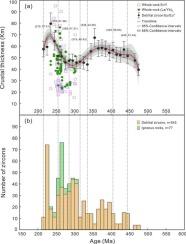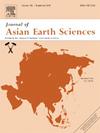A Mid-Late Permian transition from oceanic subduction to continental collision in the northern margin of the North China Craton (NE China)
IF 2.4
3区 地球科学
Q2 GEOSCIENCES, MULTIDISCIPLINARY
引用次数: 0
Abstract
The tectonic evolution of the northern margin of the North China Craton (NCC) remains controversial. In this study, we present zircon U-Pb ages, geochemistry, and Sr-Nd isotope data of andesites and dacites, and detrital zircon ages of siltstones from the Woguadi Formation in central Jilin Province, Northeast China. Dating of volcanic rocks from the Woguadi Formation yielded weighted mean ages ranging from 271 Ma to 256 Ma. The andesites are characterized by high Sr (635–746 ppm) and low Y (14.5–15.9 ppm) and Yb (1.41–1.51 ppm) contents, exhibiting geochemical affinities to adakites. Melts generated from partial melting of subducted oceanic crust interacted with peridotite during their ascent through the mantle wedge, most likely forming these andesites. The dacites show relatively low Sr (123–273 ppm) and high Y (14.7–29.4 ppm) and Yb (1.57–3.09 ppm) contents, displaying geochemical affinities to arc. These dacites formed from partial melting of crust metasomatized by fluids, sedimentary melts and mantle components, as supported by isotopic compositions (initial 87Sr/86Sr ratios of 0.7029–0.7044 and εNd(t) values of 2.22–3.02). The volcanic rocks formed in an active continental margin related to southward subduction of the Paleo-Asian Ocean (PAO) during the Mid-Late Permian. Detrital zircons from the siltstones were mainly sourced from the NCC. The crustal thickness estimated by whole-rock trace elements and detrital zircon Eu/Eu* ratios suggests that the subduction initiation of the PAO occurred at ca. 330 Ma and the NCC and neighboring arcs began to collide at ca. 270 Ma.

华北克拉通北缘中晚二叠世洋俯冲到大陆碰撞的转变
华北克拉通北缘的构造演化至今仍有争议。本文研究了吉林中部安山岩和英安岩的锆石U-Pb年龄、地球化学和Sr-Nd同位素数据,以及粉砂岩的碎屑锆石年龄。沃瓜底组火山岩的加权平均年龄为271 ~ 256 Ma。安山岩具有高Sr (635 ~ 746 ppm)、低Y (14.5 ~ 15.9 ppm)、低Yb (1.41 ~ 1.51 ppm)的特征,与埃达岩具有地球化学亲缘关系。俯冲洋壳部分熔融产生的熔体在通过地幔楔上升过程中与橄榄岩相互作用,很可能形成了这些安山岩。英安岩Sr含量较低(123 ~ 273 ppm), Y含量较高(14.7 ~ 29.4 ppm), Yb含量较高(1.57 ~ 3.09 ppm),与弧具有地球化学亲缘关系。这些英安岩由流体交代的地壳部分熔融、沉积熔体和地幔组分组成,其同位素组成(初始87Sr/86Sr比值为0.7029 ~ 0.7044,εNd(t)值为2.22 ~ 3.02)支持。火山岩形成于中晚二叠世古亚洲洋向南俯冲的活动大陆边缘。粉砂岩碎屑锆石主要来源于北陆块体。全岩微量元素和碎屑锆石Eu/Eu*比值估算的地壳厚度表明,PAO的俯冲开始于约330 Ma, NCC和邻近的弧在约270 Ma开始碰撞。
本文章由计算机程序翻译,如有差异,请以英文原文为准。
求助全文
约1分钟内获得全文
求助全文
来源期刊

Journal of Asian Earth Sciences
地学-地球科学综合
CiteScore
5.90
自引率
10.00%
发文量
324
审稿时长
71 days
期刊介绍:
Journal of Asian Earth Sciences has an open access mirror journal Journal of Asian Earth Sciences: X, sharing the same aims and scope, editorial team, submission system and rigorous peer review.
The Journal of Asian Earth Sciences is an international interdisciplinary journal devoted to all aspects of research related to the solid Earth Sciences of Asia. The Journal publishes high quality, peer-reviewed scientific papers on the regional geology, tectonics, geochemistry and geophysics of Asia. It will be devoted primarily to research papers but short communications relating to new developments of broad interest, reviews and book reviews will also be included. Papers must have international appeal and should present work of more than local significance.
The scope includes deep processes of the Asian continent and its adjacent oceans; seismology and earthquakes; orogeny, magmatism, metamorphism and volcanism; growth, deformation and destruction of the Asian crust; crust-mantle interaction; evolution of life (early life, biostratigraphy, biogeography and mass-extinction); fluids, fluxes and reservoirs of mineral and energy resources; surface processes (weathering, erosion, transport and deposition of sediments) and resulting geomorphology; and the response of the Earth to global climate change as viewed within the Asian continent and surrounding oceans.
 求助内容:
求助内容: 应助结果提醒方式:
应助结果提醒方式:


